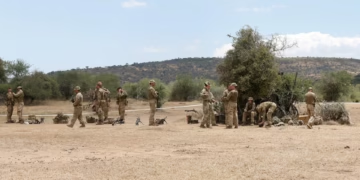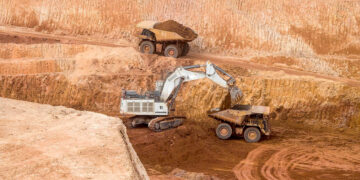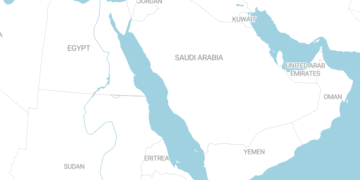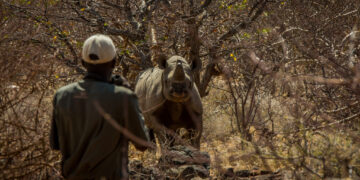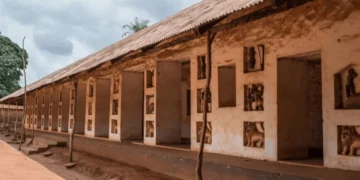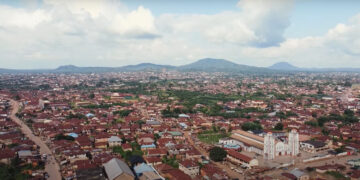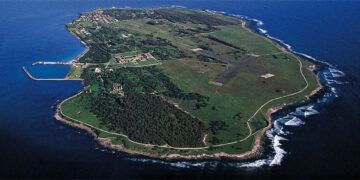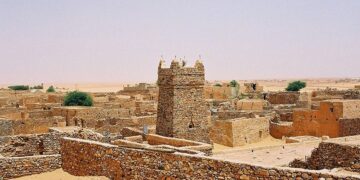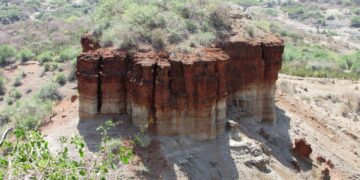The Isimila Stone Age site, located in the Southern Highlands of Tanzania, about 20 kilometers southwest of the town of Iringa, is one of the most important Paleolithic archaeological sites in East Africa. The site is famous for its dense concentration of Acheulean-period stone tools and for its unique geological formations consisting of eroded sandstone columns, which have preserved the archaeological remains in their original context.
The Isimila Stone Age site was first discovered in 1951 by D. A. Maclennan. The density of stone tools scattered across the surface attracted the attention of professional researchers, leading to systematic excavations at the site that began in the late 1950s. These early excavations were led by archaeologists whose work revealed archaeological layers rich in stone tools and fossilized animal bones preserved within ancient lake sediments.
Research at the site continued intermittently over the following decades, with recent studies focusing on understanding site formation processes (taphonomy), reconstructing ancient environments (paleoecology), and applying more accurate dating techniques to determine the age of archaeological layers. This research has contributed to establishing Isimila as a reference site for the study of the Late Acheulean period in Africa.
The Isimila Stone Age site lies within a sedimentary basin formed as a result of tectonic activity associated with the Great Rift Valley System. In the distant past, this basin contained a shallow lake whose size varied depending on climatic fluctuations. Over thousands of years, layers of sand, silt, and clay were deposited on the bottom of this lake, carrying with them stone tools left by hominin groups along its banks, as well as animal remains.
The most prominent geological feature of Isimila today is the presence of a large number of towering sandstone columns, some of which reach heights of 30 meters. These columns are not human-built structures but rather the product of natural erosion. They are composed of hardened sandstone, and their tops are capped with “caps” of ferricrete, which is more resistant to erosion. Over the ages, wind and rain have eroded the softer sand deposits surrounding these columns, while the hard caps have protected the sediments directly below, resulting in the columns forming natural monuments to ancient landscapes.
The archaeological significance of these columns lies in the fact that they are part of the original sedimentary layers that contained the stone tools. This geological process preserved the tools in situ, allowing archaeologists to study them in their precise stratigraphic context, which is vital for understanding the behavior of their makers.
The archaeological complex at Isimila belongs primarily to the Acheulean culture, a stone tool industry that lasted for a very long period (from approximately 1.7 million to 250,000 years ago) and was characterized by the production of large tools in two main forms: hand axes and cleavers.
The Isimila site contains one of the largest assemblages of Acheulean tools discovered in the world. The tools are made from various types of locally available rock, including quartzite, gneiss, and granite. The site is characterized by the presence of a large number of these tools in a good state of preservation, providing rich data for analyzing the techniques used by their makers.
The hand axes at the Isimila site exhibit a wide variety of sizes and shapes, ranging from large, heavy pieces to smaller, more finely crafted tools. These tools were likely multi-purpose, used for tasks such as butchering animal meat, breaking bones to access marrow, and processing plant material. The cleavers, characterized by their straight cutting edge, are believed to have been particularly effective for butchering and chopping tasks.
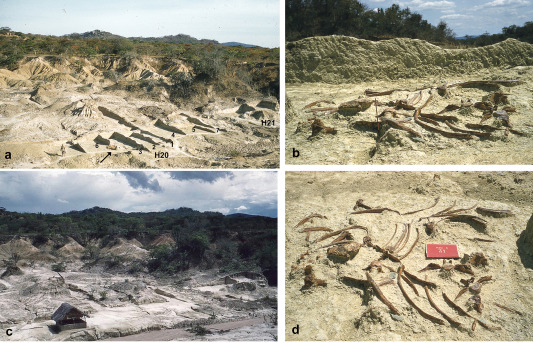
Source: Kleindienst, M. R., Blackwell, B. A., & Skinner, A. R. (2024). Isimila Prehistoric Site, Tanzania: Comparative Faunal Datings and ESR, with a Reassessment. Journal of African Earth Sciences, 211, 105156.
In addition to the axes and cleavers, the site also contains other tools such as spheroids, scrapers, and sharp stone chips resulting from the manufacturing process. The presence of such a wide variety of tools in a single location suggests that the site was the scene of multiple activities. Isimila is believed to have served as a “workshop site” or “butchering site,” where hominin groups congregated on the shores of the lake, taking advantage of the availability of water, raw materials, and animal resources.
Determining the precise age of the Isimila site has been a challenge for researchers. Early studies broadly estimated its age based on comparisons of tool types with other dated sites. However, recent studies using radiometric dating techniques, such as uranium-series dating on bones and argon-argon dating on volcanic deposits, have provided more accurate estimates. These estimates indicate that the main archaeological layers at Issemilla are between 260,000 and 500,000 years old, placing it in the late Lower Paleolithic.
The study of fossilized pollen grains and plant and animal remains has helped reconstruct the ancient environment at Issemilla. Evidence suggests the area was characterized by a mosaic environment consisting of grasslands (savannas) interspersed with forests and wooded areas along waterways and lake shores. This ecological diversity would have supported a wide range of animals, including extinct elephant species, hippopotamuses, giraffes, wild boars, and antelopes, whose fossilized remains have been found at the site. This resource-rich landscape made Isimila an attractive location for early human settlement.
Despite the discovery of thousands of stone tools, no fossilized remains of hominins have yet been discovered at the Isimila site itself. However, based on the age of the site and the type of stone industry, the manufacture of these tools is generally attributed to Homo erectus or a closely related species such as Homo heidelbergensis. These hominins were known to have spread widely across Africa, Asia, and Europe during this period and are globally associated with the Acheulean industry.
The stone tools at the Isimila Stone Age site exhibit a high degree of standardization in design, suggesting a technological tradition passed down through generations. The ability to produce these symmetrical and complex tools from large blocks of rock required advanced cognitive abilities, including advance planning, a deep understanding of the properties of raw materials, and fine manual dexterity.
The significance of the Isimila site lies in several aspects. First, it offers one of the richest and best-preserved Acheulean toolkits in their geological context, making it a natural laboratory for the study of Paleolithic technology and behavior. Second, the unique geological formations help us understand the natural processes that influence the formation and preservation of archaeological sites. Third, the site contributes to our understanding of how early hominins adapted to diverse environments and exploited the resources available to them.
Today, the Isimila site is managed as part of Tanzania’s National Heritage and is open to visitors. A small museum has been established on-site to display some of the finds and provide information about its geological and archaeological history. Isimila represents a unique window into the prehistoric world, where silent stone tools and majestic sandstone columns reveal the story of ancient human activity on the shores of a forgotten lake in the heart of Africa.







